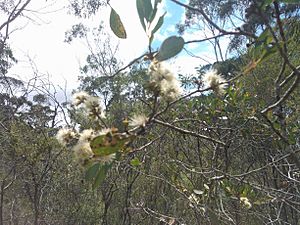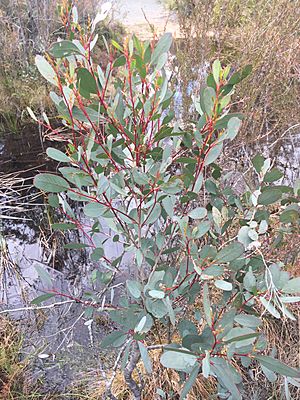Broad-leaved sally facts for kids
Quick facts for kids Broad-leaved sally |
|
|---|---|
 |
|
| Conservation status | |
| Scientific classification | |
| Genus: |
Eucalyptus
|
| Species: |
aquatica
|
Eucalyptus aquatica, often called the broad-leaved sally or mountain swamp gum, is a special type of tree or mallee (a shrubby tree with many stems). It only grows in a small part of New South Wales, Australia. This plant has smooth, greyish bark and dull bluish-green leaves. Its flowers are white, and they grow in groups of seven. After flowering, it produces cone-shaped fruits. You can find this unique plant growing in swamps and other wet areas where the ground stays very soggy.
Contents
What Does Broad-leaved Sally Look Like?
The broad-leaved sally, or Eucalyptus aquatica, can be a small tree or a mallee. A mallee is a type of eucalyptus that grows with many stems from the ground, like a bush. This plant can grow up to about 7 metres (23 feet) tall.
It has smooth, greyish bark that peels off in long strips. When the plant is young, its leaves are shiny green and shaped like an egg. They can be up to 120 mm (about 5 inches) long. As the plant gets older, its leaves become a dull bluish-green. These adult leaves are usually curved and shaped like a spear, about 50-100 mm (2-4 inches) long.
The flowers of the broad-leaved sally are white. They grow in groups of seven. Each group of flowers sits on a small stalk called a peduncle, which is about 3-7 mm long. The individual flowers also have tiny stalks called pedicels. After the flowers bloom, they turn into cone-shaped or half-sphere-shaped fruits. These fruits are about 4-7 mm long and wide.
How Did Broad-leaved Sally Get Its Name?
The broad-leaved sally was first officially described in 1934 by a person named William Blakely. He first called it Eucalyptus ovata var. aquatica. Later, in 1990, two other botanists, Lawrie Johnson and Ken Hill, changed its status to its own species. This is why its full scientific name includes their names.
The second part of its scientific name, aquatica, comes from a Latin word. It means "living in or near water." This name makes a lot of sense because the broad-leaved sally loves to grow in wet, swampy places!
There is some discussion among scientists about this plant's name. Some think it might be the same as another type of eucalyptus called E. camphora subsp. camphora. But for now, it is known as Eucalyptus aquatica.
Where Does Broad-leaved Sally Live?
Eucalyptus aquatica is mostly found in just a few places in New South Wales, Australia. It is mainly known from two swamps near a town called Penrose. In these areas, it grows in soil that is always wet, like a swamp. There has also been one sighting of this plant in Morton National Park.
Protecting Broad-leaved Sally
The broad-leaved sally is considered a "vulnerable" species. This means it is at risk of becoming endangered if we don't protect it. Both the Australian Government and the New South Wales Government have laws to help protect this plant.
The main things that threaten the broad-leaved sally are:
- Fires: Fires that happen too often or are too strong can harm the plants.
- Habitat changes: When its swampy home is changed or damaged, the plant struggles to survive.
- Weeds: Other plants that are not native to the area can grow and take over, pushing out the broad-leaved sally.
- Exotic pines: Pine trees that are not from Australia can also invade its habitat.
Protecting these special trees helps keep Australia's unique plant life healthy for the future.



